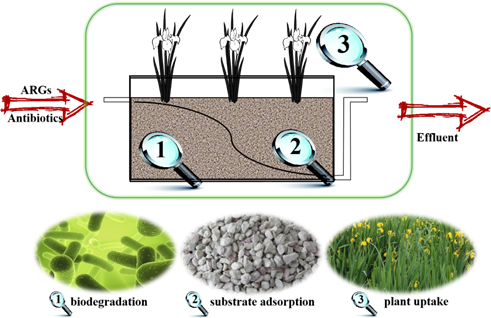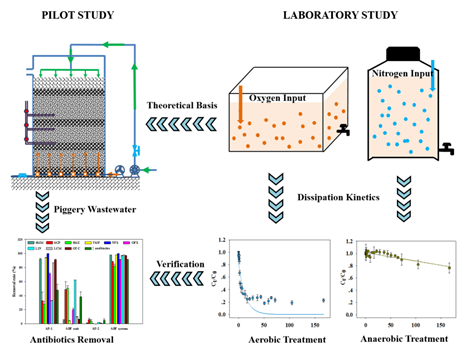We developed a series of small scale on site wastewater treatment technologies for rural domestic wastewater and livestock wastewater. We assessed their removal efficiencies for conventional water quality pollutants, as well as emerging organic pollutants such as hormones and antibiotics in the wastewater.
(1). High loading subsurface infiltration system
We have developed a high loading subsurface infiltration system to treat domestic wastewater, and studied the removal rate and mechanism of antibiotics and antibiotic resistant genes. This research mainly focused on the relationship between microbial diversity and the concentration of oxygen, COD, and PPCPs. The results shows that high removal of COD, NH3-N, pathogenic bacteria of Escherichia coli and coliform, and PPCPs such as steroids and biocides were achieved in the high loading subsurface infiltration system. Microbial degradation and substrate adsorption have been regarded as the two main removal mechanisms. The structure of bacterial and ammonia oxidizing bacteria, ammonia oxidizing function and gene abundance in the infiltration system were related to the concentrations of pH, DO, COD and NH3-N. The pH value and nitrite could affect the enrichment of acidophilic bacteria and nitrite oxidizing bacteria.

Figure 1 Microbial mechanism of contaminant removal in soil filtration system
(2). Constructed artificial wetland system
The removal potential of antibiotics and ARGs in raw domestic wastewater by mesocosm-scale CWs with different design parameters were investigated. Comprehensively considering the removal rates and removal amounts, the CW with HLR of 20 cm/day and zeolite as substrate was the best choice for treatment of the target compounds in domestic wastewater. HSSF-CWs and VSSF-CWs showed higher removal rates of target pollutants than SF-CWs, and the presence of plants is beneficial to pollutant removal. In terms of removal mechanism, substrate adsorption, plant uptake and biodegradation all contributed to the reduction of various wastewater contaminants including the nutrients, antibiotics and ARGs, but the biodegradation played the most important role.
The removal potential of antibiotics and ARGs in antibiotics-spiked domestic wastewater by two-stage (vertical subsurface down-flow CW vs horizontal subsurface flow CW) constructed wetland systems with aeration was further investigated. The results showed that two-stage CW systems had good performance of removing pollutants including nutrients, antibiotics and ARGs. Among them, the combination of aeration in the first stage and no aeration in the second stage could be the perfect choice.

Figure 2 Main mechanisms for contaminant removal in constructed wetlands

Figure 3 Design of mesocosm-scale constructed wetland systems
(3). Biological aerated filter system
We investigated the removal efficiency and mechanism for antibiotics in swine wastewater by a biological aerated filter system (BAF system) in combination with laboratory aerobic and anaerobic incubation experiments. Nine antibiotics including sulfamonomethoxine, sulfachloropyridazine, sulfamethazine, trimethoprim, norfloxacin, ofloxacin, lincomycin, leucomycin and oxytetracycline were detected in the wastewater with concentrations up to 192000 ng/L. The results from this pilot study showed efficient removals (>82%) of the conventional wastewater pollutants (BOD5, COD, TN and NH3-N) and the detected nine antibiotics by the BAF system. Laboratory simulation experiment showed first-order dissipation kinetics for the nine antibiotics in the wastewater under aerobic and anaerobic conditions. The biodegradation kinetic parameters successfully predicted the fate of the nine antibiotics in the BAF system. This suggests that biodegradation was the dominant process for antibiotic removal in the BAF system.

Figure 4 Antibiotic removal in biological aerated filter system
References
(1) Chen J, Liu YS, Su HC, Ying GG*, Liu F, Liu SS, He LY, Chen ZF, Yang YQ and Chen FR. Removal of antibiotics and antibiotic resistance genes in rural wastewater by an integrated constructed wetland. Environmental Science and Pollution Research. 2014, 22(3), 1794-1803 (IF=2.760).
(2) Chen J, Ying GG*, Liu YS, Liu SS, He LY, Su HC, Hu LX, Wei XD, Shi WJ, Chen FR, and Yang YQ. Removal of antibiotics and antibiotic resistance genes from domestic sewage by constructed wetlands: Optimization of wetland substrate and hydraulic loading. Science of the Total Environment. 2016, 565, 240–248 (IF=3.976).
(3) Chen J, Ying GG*, Liu YS, Liu SS, He LY, Su HC, Hu LX, Wei XD, Chen ZF, Chen FR, and Yang YQ. Removal of antibiotics and antibiotic resistance genes from domestic sewage by constructed wetlands: Effect of flow configuration and plant species. Science of the Total Environment. 2016, 571, 974–982 (IF=3.976).
(4) Chen J, Liu YS#, Zhang JN, Yang YQ, Hu LX, Yang YY, Zhao JL, Chen FR and Ying GG*. Removal of antibiotics from piggery wastewater by biological aerated filter system: treatment efficiency and biodegradation kinetics. Bioresource Technology. 2017, 238, 70-77 (IF=4.917).